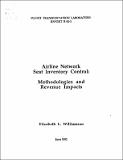Airline network seat inventory control : methodologies and revenue impacts
Author(s)
Williamson, Elizabeth Louise
DownloadFTL_R_1992_03.pdf (12.88Mb)
Other Contributors
Massachusetts Institute of Technology. Flight Transportation Laboratory
Metadata
Show full item recordAbstract
In the airline industry, it is customary for carriers to offer a wide range of fares for any given seat in the same cabin on the same flight. In order to control the number of seats made available in each fare class, airlines practice what is called seat inventory control. Traditionally, airline seat inventory control has been the process of allocating seats among varies fare classes on a flight leg in order to maximize expected revenues. Reservations for travel on a flight leg are accepted based on the availability of a particular fare class on that flight leg. A passenger's ultimate destination, overall itinerary, or total revenue contribution to the airline is not taken into account. The typical route structure of a large airline, however, is built around a complex network of connecting flights. Maximizing revenues on individual flight legs is not the same as maximizing total network revenues. The objective of this dissertation is to address the seat inventory control problem at the network level, taking into account the interaction of flight legs and the flow of traffic across a network. Beginning with the traditional network formulation of the seat inventory control problem, practical approaches for actually controlling seat inventories at the origin-destination and fare class (ODF) level are first discussed. To avoid problems associated with forecasting ODF itinerary demand, network methods based on aggregated demand estimates are then presented. Taking the network seat inventory control problem one step closer to fit in with current reservations control capabilities, several leg-based heuristics are introduced. These heuristics take into account information about different ODF passenger demand and traffic flows while optimization and control of seat inventories remains at the flight leg level. In order to effectively measure the revenue potential of the different network seat inventory control methods introduced, an integrated optimization/booking process simulation was developed. Specific issues related to realistically modeling the booking process are discussed and the multi-period, computer-based, mathematical simulation described in detail. With the use of this integrated optimization/booking process simulation, the revenue impacts of the different network seat inventory control methodologies are then evaluated using real airline data for both a connecting hub network and multiple flight leg networks. Overall performance of each method is examined by comparing the revenue obtained with that of current leg-based control approaches and the maximum revenue potential given perfect information. The performance of the different methods evaluated varies with both the network and the actual demand patterns, however, significant revenue impacts over current seat inventory control approaches can be obtained. One approach which consistently performs well is a deterministic network approach in which ODF seat allocations are nested by shadow prices. Depending on the network structure, other leg-based OD control heuristics also perform well. The benefits of network seat inventory control are a function of the load factor across a network. Below an average load factor of about 85%, revenue impacts over effective leg-based control are non-existent. However, as the average load factor increases, revenue impacts on the order of 2-4% are obtainable.
Description
Cover title June 1991 Also issued as an Ph.D. thesis, MIT Dept. of Aeronautics and Astronautics, 1992 June 1992 Includes bibliographical references (p. 254-256)
Date issued
1992Publisher
[Cambridge, Mass. : Massachusetts Institute of Technology, Dept. of Aeronautics & Astronautics], Flight Transportation Laboratory, [1992]
Other identifiers
28030370
Series/Report no.
FTL report (Massachusetts Institute of Technology. Flight Transportation Laboratory) ; R92-3
Keywords
Airlines, Aeronautics, Commercial, Demand (Economic theory), Management, Mathematical models, Rates, Passenger traffic